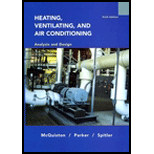
Concept explainers
Each person in a room is assumed to be producing carbon dioxide at the average rate of 0.0107 cfm (5.0 ml/s) and air with a CO2 concentration of 280 ppm is being supplied to the room at the rate of 6000 cfm (2.8 m3/s). It is desired to keep the concentration level of CO2 in the space below 1000 ppm. Assuming complete mixing, determine how many persons could occupy the room and not exceed the desired CO2 level.
Want to see the full answer?
Check out a sample textbook solution
Chapter 4 Solutions
Heating Ventilating and Air Conditioning: Analysis and Design
Additional Engineering Textbook Solutions
Thinking Like an Engineer: An Active Learning Approach (3rd Edition)
Fox and McDonald's Introduction to Fluid Mechanics
Applied Fluid Mechanics (7th Edition)
Engineering Mechanics: Statics
Applied Statics and Strength of Materials (6th Edition)
Degarmo's Materials And Processes In Manufacturing
- A two-compartment vessel contains fluid in each section. For the first compartment, the fluid density is 1,279.7 kg/m3 and for the second is 632.4 kg/m The partition is removed, allowing the fluids to mix. Determine the specific gravity of the mixture if the fluid masses are equal.arrow_forwardIdentify the state of the fluid: Ammonia at 120kPa, with a specific enthalpy of 35 kJ/kgarrow_forwardThe equipment room housing the compressor and condenser of a refrigerant ammonia system has dimensions 5 by 4 by 3 m at 1 bar room pressure. Calculate the maximum volume of the refrigerant in m3 which would have to escape into the space to cause a toxic concentration for a 1/2-h exposure.arrow_forward
- A two compartment vessel contains fluids in each sectio. For the first compartment the fluid density is 1235.4 kg/m3 and for the second 592.4 kg/m3 . The partition is removed allowing the fluids to mix. Determine the specific gravity of the mixture if the fluid masses are equalarrow_forwardA tank contains 40 lb of salt dissolved in 500 gallons of water. A brine solution is pumped into the tank at a rate of 5 gal/min; it mixes with the solution there, and then the mixture is pumped out at a rate of 5 gal/min. Determine A(t), the amount of salt in the tank at time t, if the concentration of salt in the inflow is variable and given by cin(t) = 2 + sin(t/4) lb/gal. Without actually graphing, conjecture what the solution curve of the IVP should look like. Then use a graphing utility to plot the graph of the solution on the interval [0, 300].arrow_forwardIn a steam boiler with a volume of 2 m3, there is a mixture of saturated liquid steam and water at 200 kPa pressure. Since 20% of the boiler volume is liquid and 80% is steam, calculate a- Temperature b- Total mass c- Degree of dryness d- Specific volume e- Enthalpy of the mixture.arrow_forward
- Water, m = 110.27 g, is mixed with 111.33 g of an unknown fluid with specific weight of 0.158 kip/ft³. Determine the specific volume in in /slug of the resulting mixture, assuming that the volumes are additive, and the mixture is homogenous,arrow_forward150 grams of water are mixed with 150 grams of another fluid (800 kg/m3). What is the specific volume of the resulting mixture? Assume that volumes are additive and the mixture is homogenous.arrow_forwardIf the temperature of the air is 30ºC and the substance cools from 100ºC to 60ºC in 25 minutes, identify the time when the temperature will be 40ºC.arrow_forward
- Oxygen (O2) inside a tank of volume 2.3 ft3 has a pressure of 2200 psig and is at 70°F. Part ofthe gas was used, the pressure and temperature dropped to; 1502 psig and 50°F. The tank isrigid. Determine the mass of oxygen used (lbm). MW of O2 is 32.arrow_forwardIn a paint manufacturing process, two different colored paints are being mixed in an infinitelylarge drum.Paint A, with a concentration of 30% pigment, is pumped into the drum at a rate of 10 liters perminute.Paint B, with a concentration of 17% pigment, is pumped into the drum at a rate of 17 liters perminute.Both paints have the same density of 1.0 kg/liter.If the mixture is continuously stirrred and drained from the drum at a rate of 22 liters perminute, what is the concentration of pigment in the resulting mixture as a percentage?arrow_forwardCarbon dioxide and oxygen is placed each inside a 1 m^3 tank separated by an isolation valve. Initially, carbon dioxide has the following properties: P=20 kPag & T=25 degrees celsius and that oxygen has the following properties: P=30 kPag & T=75 degrees celsius. If heat is being prevented to escape in the outside surroundings, determine the resulting temperature of the mixture if it is found that after opening the isolation valve, the resulting presure on both tank if 25 kPag.arrow_forward
 Elements Of ElectromagneticsMechanical EngineeringISBN:9780190698614Author:Sadiku, Matthew N. O.Publisher:Oxford University Press
Elements Of ElectromagneticsMechanical EngineeringISBN:9780190698614Author:Sadiku, Matthew N. O.Publisher:Oxford University Press Mechanics of Materials (10th Edition)Mechanical EngineeringISBN:9780134319650Author:Russell C. HibbelerPublisher:PEARSON
Mechanics of Materials (10th Edition)Mechanical EngineeringISBN:9780134319650Author:Russell C. HibbelerPublisher:PEARSON Thermodynamics: An Engineering ApproachMechanical EngineeringISBN:9781259822674Author:Yunus A. Cengel Dr., Michael A. BolesPublisher:McGraw-Hill Education
Thermodynamics: An Engineering ApproachMechanical EngineeringISBN:9781259822674Author:Yunus A. Cengel Dr., Michael A. BolesPublisher:McGraw-Hill Education Control Systems EngineeringMechanical EngineeringISBN:9781118170519Author:Norman S. NisePublisher:WILEY
Control Systems EngineeringMechanical EngineeringISBN:9781118170519Author:Norman S. NisePublisher:WILEY Mechanics of Materials (MindTap Course List)Mechanical EngineeringISBN:9781337093347Author:Barry J. Goodno, James M. GerePublisher:Cengage Learning
Mechanics of Materials (MindTap Course List)Mechanical EngineeringISBN:9781337093347Author:Barry J. Goodno, James M. GerePublisher:Cengage Learning Engineering Mechanics: StaticsMechanical EngineeringISBN:9781118807330Author:James L. Meriam, L. G. Kraige, J. N. BoltonPublisher:WILEY
Engineering Mechanics: StaticsMechanical EngineeringISBN:9781118807330Author:James L. Meriam, L. G. Kraige, J. N. BoltonPublisher:WILEY





